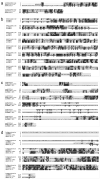Screening a genome-wide S. pombe deletion library identifies novel genes and pathways involved in genome stability maintenance
- PMID: 19264558
- PMCID: PMC2675035
- DOI: 10.1016/j.dnarep.2009.01.016
Screening a genome-wide S. pombe deletion library identifies novel genes and pathways involved in genome stability maintenance
Abstract
The maintenance of genome stability is essential for an organism to avoid cell death and cancer. Based on screens for mutant sensitivity against DNA damaging agents a large number of DNA repair and DNA damage checkpoint genes have previously been identified in genetically amenable model organisms. These screens have however not been exhaustive and various genes have been, and remain to be, identified by other means. We therefore screened a genome-wide Schizosaccharomyces pombe deletion library for mutants sensitive against various DNA damaging agents. Screening the library on different concentrations of these genotoxins allowed us to assign a semi-quantitative score to each mutant expressing the degree of sensitivity. We isolated a total of 229 mutants which show sensitivity to one or more of the DNA damaging agents used. This set of mutants was significantly enriched for processes involved in DNA replication, DNA repair, DNA damage checkpoint, response to UV, mating type switching, telomere length maintenance and meiosis, and also for processes involved in the establishment and maintenance of chromatin architecture (notably members of the SAGA complex), transcription (members of the CCR4-Not complex) and microtubule related processes (members of the DASH complex). We also identified 23 sensitive mutants which had previously been classified as "sequence orphan" or as "conserved hypothetical". Among these, we identified genes showing extensive homology to CtIP, Stra13, Ybp1/Ybp2, Human Fragile X mental retardation interacting protein NUFIP1, and Aprataxin. The identification of these homologues will provide a basis for the further characterisation of the role of these conserved proteins in the genetically amenable model organism S. pombe.
Figures




Similar articles
-
Identification of novel genes involved in DNA damage response by screening a genome-wide Schizosaccharomyces pombe deletion library.BMC Genomics. 2012 Nov 23;13:662. doi: 10.1186/1471-2164-13-662. BMC Genomics. 2012. PMID: 23173672 Free PMC article.
-
The role of novel genes rrp1(+) and rrp2(+) in the repair of DNA damage in Schizosaccharomyces pombe.DNA Repair (Amst). 2009 May 1;8(5):627-36. doi: 10.1016/j.dnarep.2008.12.008. Epub 2009 Jan 29. DNA Repair (Amst). 2009. PMID: 19185548
-
Molecular characterization of the Schizosaccharomyces pombe nbs1+ gene involved in DNA repair and telomere maintenance.Mol Cell Biol. 2003 Sep;23(18):6553-63. doi: 10.1128/MCB.23.18.6553-6563.2003. Mol Cell Biol. 2003. PMID: 12944481 Free PMC article.
-
Linking the organization of DNA replication with genome maintenance.Curr Genet. 2019 Jun;65(3):677-683. doi: 10.1007/s00294-018-0923-8. Epub 2019 Jan 2. Curr Genet. 2019. PMID: 30600398 Review.
-
Genetic approaches to aging in budding and fission yeasts: new connections and new opportunities.Subcell Biochem. 2012;57:291-314. doi: 10.1007/978-94-007-2561-4_13. Subcell Biochem. 2012. PMID: 22094427 Review.
Cited by
-
Dbl2 Regulates Rad51 and DNA Joint Molecule Metabolism to Ensure Proper Meiotic Chromosome Segregation.PLoS Genet. 2016 Jun 15;12(6):e1006102. doi: 10.1371/journal.pgen.1006102. eCollection 2016 Jun. PLoS Genet. 2016. PMID: 27304859 Free PMC article.
-
Defining genetic factors that modulate intergenerational CAG repeat instability in Drosophila melanogaster.Genetics. 2011 Jan;187(1):61-71. doi: 10.1534/genetics.110.121418. Epub 2010 Nov 1. Genetics. 2011. PMID: 21041558 Free PMC article.
-
Broad functional profiling of fission yeast proteins using phenomics and machine learning.Elife. 2023 Oct 3;12:RP88229. doi: 10.7554/eLife.88229. Elife. 2023. PMID: 37787768 Free PMC article.
-
Characterization of ypa1 and ypa2, the Schizosaccharomyces pombe orthologs of the peptidyl proyl isomerases that activate PP2A, reveals a role for Ypa2p in the regulation of cytokinesis.Genetics. 2012 Apr;190(4):1235-50. doi: 10.1534/genetics.111.138040. Epub 2012 Jan 20. Genetics. 2012. PMID: 22267499 Free PMC article.
-
Genetic Interaction Landscape Reveals Critical Requirements for Schizosaccharomyces pombe Brc1 in DNA Damage Response Mutants.G3 (Bethesda). 2015 Mar 19;5(5):953-62. doi: 10.1534/g3.115.017251. G3 (Bethesda). 2015. PMID: 25795664 Free PMC article.
References
-
- Dianov GL, Parsons JL. Co-ordination of DNA single strand break repair. DNA Repair (Amst) 2007;6:454–60. - PubMed
-
- Raji H, Hartsuiker E. Double-strand break repair and homologous recombination in Schizosaccharomyces pombe. Yeast. 2006;23:963–76. - PubMed
-
- Friedberg EC. Suffering in silence. Nat Rev Mol Cell Biol. 2005;6:943–53. - PubMed
Publication types
MeSH terms
Substances
Grants and funding
LinkOut - more resources
Full Text Sources
Molecular Biology Databases

